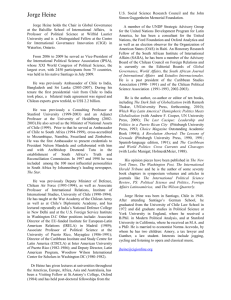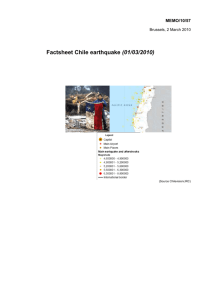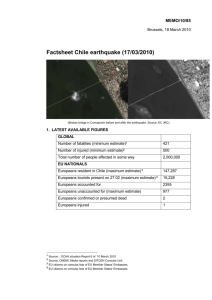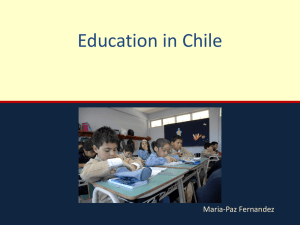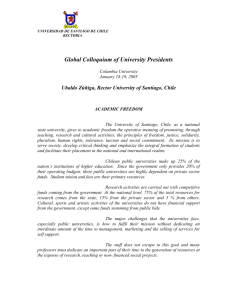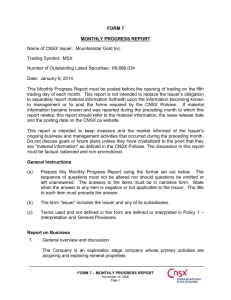DOC - Europa
advertisement
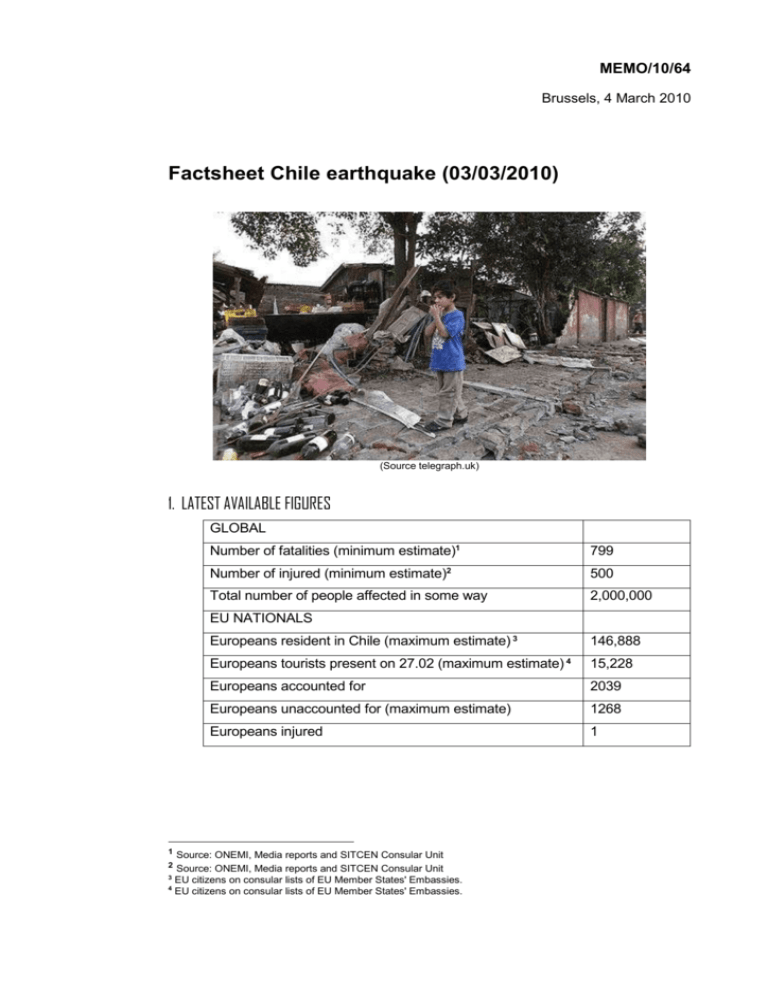
MEMO/10/64 Brussels, 4 March 2010 Factsheet Chile earthquake (03/03/2010) (Source telegraph.uk) 1. LATEST AVAILABLE FIGURES GLOBAL Number of fatalities (minimum estimate)1 799 Number of injured (minimum estimate)2 500 Total number of people affected in some way 2,000,000 EU NATIONALS 1 Europeans resident in Chile (maximum estimate) 3 146,888 Europeans tourists present on 27.02 (maximum estimate) 4 15,228 Europeans accounted for 2039 Europeans unaccounted for (maximum estimate) 1268 Europeans injured 1 Source: ONEMI, Media reports and SITCEN Consular Unit Source: ONEMI, Media reports and SITCEN Consular Unit 3 EU citizens on consular lists of EU Member States' Embassies. 4 EU citizens on consular lists of EU Member States' Embassies. 2 2. SITUATION in CHILE On 27 February a powerful 8.8 magnitude earthquake hit central Chile. Since the initial quake, the U.S. Geological Survey reports 122 aftershocks of magnitude 5.0 or greater (including the 6.1 aftershock of the 3.3.2010). Eight of these aftershocks have had a magnitude of 6.0 or greater. According to the National Emergency Office (ONEMI), the current number of confirmed fatalities is 799 and 2 missing people. More than 350 people died in the coastal town of Constitución (Maule region) due to waves from a tsunami. No reported deaths (so far) of EU Member State citizens. One Belgian citizen is injured. The death toll is expected to continue to rise as communications are restored with the most affected areas. Those Member States that have Consulates in Chile confirmed that they would seek to provide assistance to any MS citizen that requests it. Some EU Member States have substantial numbers of nationals in Chile (Italy 50 000, Spain about 31 000, Germany about 30 000 and the UK about 5000). However, these figures mostly refer to people with dual nationality, which are long-term residents in the country and are certainly not in need of evacuation. Most affected regions: Maule, Bio-Bio, Araucania, Santiago, Valparaíso and O'Higgins. Search and Rescue (SAR) Teams are still operative in affected areas. Evacuation of injured still ongoing mainly in Bio-Bio and Maule regions. The latest official reported figures show over 2 million people have been affected by the quake. An estimated 500,000 houses have been seriously damaged and some 1,5 million houses have been affected. A national state of emergency has been declared for Maule and Bio-Bio regions. President Bachelet has affirmed that 80% of the Chilean population has been affected in some way. First estimate from Eqecat – a U.S. company involved in risk analysis for insurance companies – indicate that the quake could cost between $15 and $30 billion (the equivalent of 15% of Chile’s GDP). Chile’s national debt stands at 6% of its annual GDP, the country’s Social and Economic Stabilization Fund holds USD 11.3 billion (source: Global Insight). Price of copper may raise as a result of limited power supplies and curtail exports. The World Bank and the Inter-American Development Bank (IADB) have opened credit lines for Chile. Chile's new government takes power on Thursday 11 March. Albeit the polemics between the Chilean Navy and ONEMI on the failed tsunami alert, President elect Sebastián Piñera has said that he wants the current head of ONEMI, Carmen Fernandez, to stay on after his administration takes office. Main Challenges for International assistance Security: The government imposed a night-time curfew (from 9 pm to 6 am local time) in seven cities: Curico, Molina, Sagrada Familia, Conception, Talca, Cauquenes, Constitution (AFP). The Chilean army and the Navy are contributing to the security on the ground with 14.000 soldiers, 50 transport planes, and 3 vessels. Health In southern Chile, six hospitals collapsed and two others were damaged severely and left unable to function. Hospitals in the Metropolitan Region, where Santiago is located, are functioning. In the disaster zone (from Valparaíso to Araucania), eight hospitals are unusable and ten have suffered major damage and are being evaluated. A principal public hospital has closed in Santiago. It is reported that, due to extent of damage, it may be less costly to rebuild rather than repair. In terms of loss of health services, Maule is the most affected. Four of its seven hospitals do not function. The other three hospitals are known to have been damaged, but continue to function providing limited services. 2 Electricity supply: The Chilean national company has announced that 89% of their clients already have electrical supply, even if 165.000 families are not yet receiving the service. Airports: In the main airport in Santiago operations began to normalize progressively in the flow of inbound and outbound flights. On 3 March Chile's biggest airline has restarted restart 15% of operations. Roads: Many roads are damaged (see details in Google Maps) 5. The Chilean government has officially requested on 1 March 2010 international assistance in the following domains: mechanical bridges, field hospitals with surgical capacity, satellite telephones and relay stations, generators, salt water purification systems, shelter, self-dialysis units6, field kitchens, USAR (Urban Search and Rescue) teams. On March 03rd President Bachelet has declared to the press that there is no shortage of food and fuel in the country. 4. EU Emergency response 4.1. Humanitarian Effort On 28 February DG ECHO adopted a € 3 million Primary Emergency Decision. A team of humanitarian experts has been deployed to the affected area. Close contact is being maintained with ECHO partners, the EU Delegation in Chile, Member States, ONEMI and regional partners. To avoid outbreaks of Hepatitis A, Chile has asked for 800.000 doses of the vaccine and PAHO/WHO is looking into securing a donation from pharmaceutical producers. Further detailed information is expected in the coming days, as many humanitarian agencies are carrying out needs assessments. 4.2 Civil Protection coordinated by MIC The EU Civil Protection Mechanism issued a pre-alert message to the Participating States immediately after the earthquake on 27 February and was activated on 1 March, following the request for international assistance from the Chilean President (see point 3). In-kind assistance (including mechanical bridges and tents) has been offered. MIC is also prepared to deploy a coordination and assessment team, including earthquake damage assessment specialists. The first part of the team (6 experts) will be tasked with ensuring liaison with the Chilean authorities, coordinating incoming European assistance and participating to the needs assessments. The exact date of its departure depends on when the Chilean authorities will accept the offered assistance. According to preliminary arrangements, the team is scheduled to arrive in Chile (Santiago) on 5 March. The mission will last about two weeks. The team will likely be deployed together with a Technical Assistance and Support team (TAST) module, so that it can be self-sufficient on site. MIC plans to deploy an Advanced Medical Post (AMP) with Surgery as well. Both the European TAST and the AMP are on stand-by under the Preparatory Action for EU Rapid Response capacity. Spain has informed the MIC of having already sent assistance on 2 March consisting of Urban Search and Rescue (USAR), medical and assessment teams. 5 More information is available on http://maps.google.cl/maps/ms?hl=es&gl=cl&ie=UTF8&oe=UTF8&msa=0&msid=101583086025908752159.000480adeb62 2070a2cd4 6 Autonomous units 3 5. EU Ongoing Cooperation with Chile (Background) The relations between Chile and the EU are long-standing and excellent. The EUChile Association Agreement entered into force in 2005 and is the cornerstone of the relation covering a wide range of political, cooperation and trade issues. Chile actively supports EU policies and standards in the region. Political dialogue meetings take place regularly at all level. The EU is the main source of FDI for Chile and EUChile trade amounted to €16B in 2008. The envelope for development cooperation with Chile for the period 2007-2013 amounts to €41million, matched by the same amount from Chile’s side. Funds are earmarked for three priority sectors: social cohesion, innovation & competitiveness and education. These funds are programmed in close cooperation with the Chilean authorities, For more information and to download relevant documents please consult the EU External Action site at: http://eeas.europa.eu/news/index_en.htm The European Commission's Joint Research Centre funded by the Instrument for Stability provides maps and analysis at: http://www.gdacs.org/ 4
